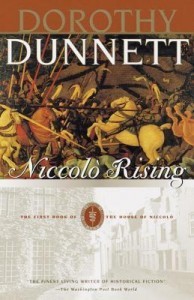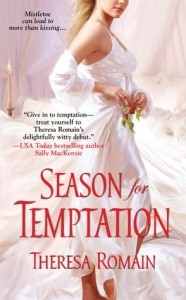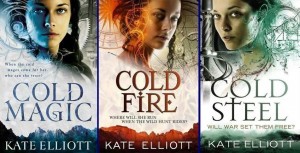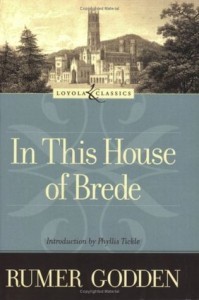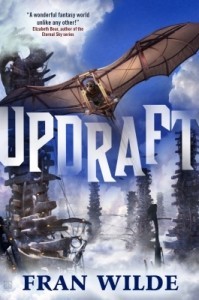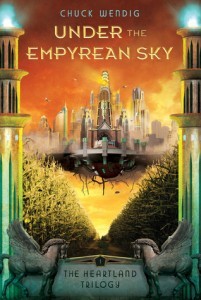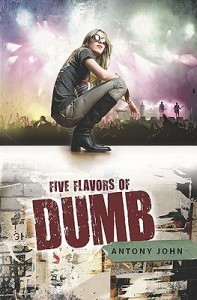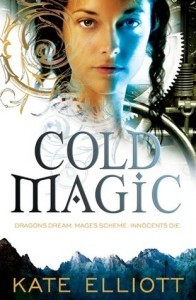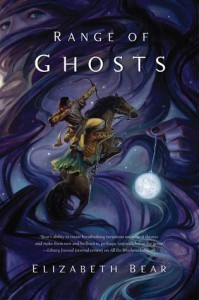Rachel Neumeier's Blog, page 327
September 8, 2015
Unfinished series
Here’s a post that caught my eye at By Singing Light: Top ten series I’ve never finished. Of course the reason this post got my attention is that I’ve read so many of the series in question — Chanur! Hambly’s James Asher series! Others, too.
My first impression: my gosh, how can you not finish a series you’ve started?
My second thought: wow, you know, there are a surprising number of series *I* haven’t finished even though I started them. I mean, even if the series is out and finished. Obviously it doesn’t count if the only reason you haven’t finished the series is because it’s not finished yet. But! I’ve left series unfinished more than I thought. I don’t believe I can fill up a top ten list, but maybe a top five:
1. The Pathfinder series by Orson Scott Card. I read the first one; liked it quite a bit — so many different takes on time-related superpowers, it was just fascinating. Then I bought the second one but haven’t read it,and haven’t yet bought the third book.
2. The Dagger and the Coin series by Daniel Abraham. I read The Dragon’s Path; I *really loved* some aspects of the book and some characters, *really loathed* some elements and some other characters, and felt *highly concerned* at where the series might be going. So I never went on, but I didn’t get rid of the first book, either because I can see myself eventually picking the series back up.
3. The Fire and Thorns trilogy by Rae Carson. I read Girl of Fire and Thorns when it came out — in 2011, I see — liked it a lot, bought the other two, and have never quite got around to re-reading the first and going on with the others. I think this is 90% feeling like I don’t have time to read longer works and 10% fear that the series will go in a direction I really dislike. It seemed to me there was some potential for that to happen.
4. The Jinx series by Sage Blackwood. I read Jinx and loved it, read Jinx’s Magic and loved it, and haven’t read the third even though it came out in March. In this case, not going on with the series is 100% because I haven’t had time to re-read the earlier books with the attention they deserve.
5. The Lightbringer series by Brent Weeks. His Night Angel series was just a bit too dark for me, but The Black Prism was just that little bit less grim. I liked it very much and bought the second and third books, but I haven’t ever read them.
However, I see from Goodreads that a 4th book is expected to come out next year, so maybe that’s just as well. I hate being stuck with cliffhangers, and I guess this series doesn’t really count as unfinished-by-me since the author himself hasn’t finished it yet. Just-waiting-on-sequels is another and quite different (and larger) category for me.
6. And for something a tiny bit different: the series it took me the longest to complete, so far, is . . . Dorothy Dunnett’s Niccolo series.
Somewhere in the middle, such terrible things pile up on the main character that I couldn’t stand it and just quit. Ages later, I finally came back and finished the series, only because I was sure . . . pretty sure . . . that Dunnett would eventually work her way to a happier ending. Which she did. But, people! Be aware that if you make things too overwhelmingly grim for your protagonist, you are likely to see some series drop off as some readers refuse to follow your protagonist that far down into the abyss.

September 4, 2015
Characters who are sensualists
So, Kate Elliot commented that she was pleased I noted that Cat in the Spiritwalker trilogy is a sensualist. I know what she means — I remember how particularly pleased I was when a reviewer noticed how, in The City in the Lake, The Bastard shifted to being called by name, Neill, over the course of the story. It’s wonderful when readers pick up on subtle details you agonized over!
But, sensual characters, yes, I think they are quite rare, but this is a characteristic I particularly notice and enjoy. I love it when characters enjoy life and take pleasure in the sensual world. I like that in real people, too, come to think of it. I’m not really that way myself, which is perhaps why I appreciate it in other people.
Kate commented that girls in particular get criticized for enjoying things, and this does sometimes seem to be true, doesn’t it? Girls get more comments about their big appetites and more critical comments when they pick up a second piece of cake, among other things. Even I have noticed that, and all my life I seem to have had a Not Interested In Your Intrusive Comments aura that mostly prevented anybody from directing such comments at me.
I wonder if sometimes an emphasis on plot and pacing and so on doesn’t tend to drive authors away from sensory detail. Or is it seen as shallow to enjoy sensory pleasures? Or are authors often inclined to write more intellectual characters because they themselves are more intellectual and less sensualist? I think we see a disproportionate number of introverted protagonists for that reason.
Off the top of my head, I can only think of three protagonists who are true sensualists, interestingly enough in three different genres:
1. Cat in the Spiritwalker trilogy. She loves food, she sinks into the experience of eating. This gives the reader a wonderful sense of the world through the taste of yam pudding and even ordinary porridge, though nothing will persuade me that turnips are worth bothering with. Cat also enjoys sex, though I was personally just as pleased to have this left non-explicit. Even Cat’s enjoyment of her husband’s vanity is part of her own sensuality. So is her physical enjoyment of sports such as batey.
2. Aud Torvigen in the suspense series by Nicola Griffith starting with The Blue Place and continuing with Stay and Always. Incidentally, my favorite book of the trilogy is the second. I just mention that because of the general assumption that second books are weak: of course they frequently aren’t weak at all and definitely not in this case. Anyway, Aud is very much a sensualist, though for her we see this less through food and more through her tactile and physical focus. Aud is an extremely physical person who simply pours herself into physical experience, whether this involves planing boards silk-smooth when building a house from scratch or dancing or fighting or sex. She is very much capable of living in the moment, which I think is also an important part of being a sensualist.
3. Julia in Theresa Romain’s charming, light, frothy Regency romance Season for Temptation. Julia is another girl who loves food, lives in the moment, is charmingly impetuous, and thoroughly enjoys life. Theresa Romain also managed to pull of a nearly unique trick: she wrote an explicit sex scene that didn’t make me skim lightly across it.
Okay! So that’s three sensualist protagonists. Oddly, they are all female. Surely there are male characters who are sensualists? Can you think of any others, male or female?

September 3, 2015
Recent Reading: The Spiritwalker trilogy by Kate Elliot
So, the only thing I’d read by Elliot before was the Jaran quadrilogy. I read that series as the books were released, starting in 1992. I absolutely loved the first book and then liked the other three, but felt that the overall situation was not really resolved by the ending. Still, I’m surprised that I never picked up anything else by Elliot, who it turns out has written more than I thought.
Here’s a post where she lays out her books so you can see what all she’s written and which of her series might particularly appeal to you – my natural length is 120,000 words, give or take, but hers appears to be more in the neighborhood of 500,000 words. I wonder if she tends to have a clear idea of the whole outline before she starts a work of that length? It’s hard to imagine keeping that much in your head, I must say.
So, anyway, the Spiritwalker trilogy: Cold Magic, Cold Fire, and Cold Steel.
I enjoyed these books a great deal, and I’m glad I made time for a longish trilogy, even though I had to break in the middle to do revise Door Into Light. If you’re thinking of trying them, I strongly suggest that you get them in paper, at least one of them, because the map in the front is completely unreadable on a Kindle, and it is truly a most interesting map – I looked at it via the Take A Look feature on Amazon.
The map is so interesting because the alternate history is so baroque. Let me lay that out a little.
First, we are in the Gaslamp era, but also still in a heavily glaciated epoch. I believe ice stretches across a lot of what is for us the United States, though the map doesn’t show that. Deep history must be quite different in this world, because dinosaurs didn’t die out; in the Americas, troödons gave rise to the “feathered people,” just as in Africa apes gave rise to the hominids.
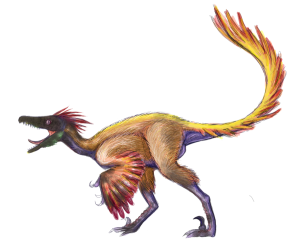
A troodon probably looked something like this
I have never seen such a fabulous nonhuman species in a fantasy series. Never. I just love how the feathered people are designed. They are so unhuman. Their underlying instincts are so clearly different from human instincts. The reader is not bashed over the head with this, the feathered people are a crucial but relatively small element in the book, but it is obvious. They are simply wonderful. So that’s one element – these sentient troödon descendants.
Second, waaaay back when (not sure how long ago, but a while), an important West African empire dug too far down in the salt mines and let loose the “salt plague” – at first the reader has no idea that this is a zombie element, and if zombies are a turn off for you, have no fear! You are not bashed over the head with the zombies, either. They are an important background element, occasionally brought into the foreground, but this is not by any stretch of the imagination a “zombie book”. In the Cold Magic trilogy, the historical importance of the salt plague is that it drove a mass migration from West Africa to Europe; the mages of both the African empire and the Celts found common ground and basically established a powerful empire drawing on both traditions. This gives us the main background culture for the story.
Oh, and third, the Roman Empire is still more or less a going concern.
And fourth, we wind up in the Antilles for quite a lot of the trilogy, where we find a quite distinctive civilization; the European colony city of Expedition exists at the edge of the Taino culture and features, by the way, a great creole type of language that must have given the copy editors absolute fits.
So the background is, as I say, baroque – and that’s before getting to the magic, though ordinary mortal magic is in fact quite straightforward in comparison, with cold mages and fire mages. One of the cleverest details is how the cold mages can’t walk by a fire without putting it out, and thus mage houses are heated via a Roman hypocaust system.
In addition to normal magic, though, there is the spirit world and the Wild Hunt and shapeshifting sabertoothed cats, not to mention the dragons . . . once again, baroque complications flower off in all directions.
Also I’ve left out the extreme tension between the mage houses and noble lineages who hold all the power, and the common people who are just at the edge of demanding legal rights. It’s like the peasants’ revolt in Britain in 1381 AD, only on a larger scale and with complications like the Napoleon-esque Camjiata, determined to conquer all of Europe and establish a new legal system, though he sure is determined to rule as Emperor himself no matter what he promises – he could be the scariest guy in the trilogy, though in such a civilized way.
So. That’s the background.
Now, the protagonist. What counts as epic fantasy for you? This is a big, complicated work, but we have exactly one pov protagonist, which means I’m not sure whether to call the trilogy “epic fantasy” or not. Also, the narration is first person, which also serves to give a more intimate feel to the story than I would generally think of for epic fantasy. On the other hand . . . the trilogy does “feel” like epic fantasy to me, more than anything else.
Though I don’t necessarily object to a clutter of pov protagonists, I did like Catherine Barr Barahel – Cat. Since the story is Cat’s, you have to like her voice or you won’t care for the trilogy. I did like her. She is one of the relatively few impulsive heroines who really works for me, probably because she is smart, brave, stubborn, and loyal. I also like how much of a sensualist she is – that’s relatively rare, I think, and it is a trait that helps the reader feel immersed in the world. For a while I did feel Cat was being pretty stupid about various things, but not (usually) so much so as to be really annoying, and anyway she can eventually accept the obvious when it bashes her over the head hard enough.
Cat’s story starts off like a YA story, and rather slowly. We see her world and family, and her cousin and best friend Bee (Beatrice) – the relationship between Cat and Bee is the most important relationship in the story. The story really starts when Cat is unexpectedly forced to marry a very powerful young cold mage, Andevai Diarisso Haranwy, who incidentally is enormously appealing, with his mix of vanity and confidence and insecurity. I’m sure you can see this coming, but of course Cat eventually falls for him even though at first she detests him.
And then we go from there, with the good guys getting together and being wrenched apart, and facing down villains, and basically trying to save each other and the world.
In some ways the villains are the best part — Camjiata with his suave, sympathetic conviction that he should be emperor; the master of the Wild Hunt with his inhuman detachment and casual cruelty; the mansa of Four Moons House with his certainty that people of good birth, like him, should naturally be able to dispose of lesser beings like villagers — he actually grew on me at the end; and of course the fire mage James Drake, who when we first meet him seems like a perfectly okay guy and then every. single. time. he reappears, he reveals himself as worse than we thought.
So. Here we have a story that opens slowly and then adds one complication after another, with important female friendships, important male friendships, complicated family relationships, angsty romances, good guys that you can root for even though they’re flawed, bad guys that you can love to hate, intelligent troödons, and complicated culture clashes. And dragons. If you’re in the mood for a fairly intimate-scale story told against a cluttered, ornate background, this might be exactly what you want.
If you’ve read this, what did you think?
My next Kate Elliot story will be the Crossroads trilogy, cause I picked up Traitor’s Gate somewhere and it’s sitting on my TBR shelves right now. It’s the third book, naturally, but since I have it, of course I’ll try the first book and then move on with the trilogy.
But first! Just got editorial comments back on The Mountain of Kept Memory, so, yeah, back to, as they say, the salt mines. That phrase is going to sound a little different to me now, after the salt plague…

September 2, 2015
Authors who take up the most shelf space
So, via twitter, I noticed this post at Random Musings: Authors I own the most books from. I’m sure . . . pretty sure . . . I’ve posted a similar list before, but my reactions to Brandy’s list were threefold:
a) 18 books by CS Lewis, wow. (I think I have only two of his.)
b) Diana Wynne Jones, of course!
c) Authors can actually be on your list when you own fewer than ten books by them?
The thing is, I am the kind of reader who is an author’s best friend: a collector. Once I fall in love with an author’s work, I pick up everything by them even if I don’t expect to get around to reading the entire backlist all that soon. It is impossible for any author to be a “most shelf space” author for me with fewer than twenty titles. In fact, here are the twelve authors who have at least 20 books on my shelves (including virtual shelves, but all but one of these I own mostly in paper):
1. Dorothy Dunnett — 20. I own her Lymond series, her Niccolo series, and all her mysteries.
2. Terry Pratchett — 20, again. I have a lot of his as audio books, including most of the Vimes books and all of Tiffany series. They work better for me as audio than any other author I’ve tried in that form.
3. Martha Wells — 21. She is the only author on this list that I own mostly in ebook form. I have all of hers except the Raksura trilogy as ebooks. This is because I only discovered her work after I got a Kindle. Everyone else on this list, I’ve been reading for a lot longer.
4. Sharon Shinn — 24. I have those I prefer and those I like less, but basically I pick up anything Sharon Shinn writes. Jeweled Fire is one of my most-anticipated titles for this fall.
5. Steven Brust — 24. All those Vlad Taltos books add up, and I grab each one the moment it’s out, but I have most of his other books too, obviously.
6. Orson Scott Card — 25. In fact, I need to pick up the third Pathfinder book one of these days. Card seems to me to be rather uneven, but I really love some of his books. Enchantment is one of his recent titles that I thought was really good.
7. Rumer Godden — 26. This is the only literary author I have a lot by. She is such a wonderful writer. In This House of Brede is one of the most beautiful books I’ve ever read. I have quite a few of hers I haven’t read, though, because I didn’t want to read them all at once and run out, and because for me they’re better read one at a time. I need to bring one of hers upstairs so I will read it soon.
8. Diana Wynne Jones — 27. I think I’m getting pretty close to having all of hers, but some I have only read once and need to read again. Hexwood comes to mind.
9. Patricia McKillip — 27. I got rid of Solstice Wood, but basically anything she writes is likely to become an instant favorite of mine.
10. Ngaio Marsh — 29. My mother loves some of the older mystery authors and got me reading Marsh.
11. Barbara Hambly — 36. It’s such a high number because I really like most of her older fantasy AND her current mysteries and urban fantasy, plus I am counting the “Barbara Hamilton” historical mysteries. Every now and then she writes a book that doesn’t work for me at all, but mostly she’s one of my favorite authors.
12. And now . . . with twice as many books as any other author . . . *Drumroll* . . . CJ Cherryh — 70 titles. Wow. And that’s without the Rusalka trilogy, which I gave away. I am counting the shared-world Marovingen Nights collections, though.
So. Any of you have more than twenty books by a single author? Who?

September 1, 2015
Amazing what you can cook in the microwave
So, my induction cooktop has gone on the fritz, and thus here I am with no cooktop. Someone is supposed to come out on the 14th to fix it. It will have been broken for 3 weeks by then, and then what do you bet they need to order a part and it takes another three weeks to actually get fixed? And costs an arm and a leg, too, I expect.
But that’s not the interesting part. That’s just the annoying part. This is the interesting part:
Did you realize you can cook medium-coarse bulgur in the microwave? I got the water boiling, then cooked the bowl for 30 seconds, then off for 3 minutes, then 30 more seconds, etc. The bulgur cooked perfectly. I was making bulgur with eggplant and halloumi cheese, in case you’re curious.
Feeling a bit under the weather? You can cook ramen noodles — my usual alternative to canned chicken soup, which I don’t like — in the microwave. The noodles came out starchy, but okay considering I was not in a mood to care.
Eggs, not very easily or very well. I don’t find that the broiler works well for eggs, either. I miss being able to use my small skillet on the stove. Usually I use my electric skillet mainly for pancakes, but finally I realized I could of course use it for eggs. It’s way too big for just one egg, but that’s life.
I made chili yesterday. I know, it’s far too hot for chili, but all these peppers were coming off the plants, so I made chili with pork shoulder and tomatoes and lots and lots of roasted, chopped, seeded chilies. Anaheims, mostly, plus hot wax peppers and jalapenos. Then I figured out how to use the slow-cook feature offered by my oven and cooked the chili for nine hours on low. I had never even noticed the slow-cook button before, so that was nice to discover.
Rice, I guess, is impossible. Unless it can be cooked in the oven, I suppose. I am not desperate enough to try that, yet.
Cooking raspberries into a sauce, no.
Steaming Chinese dumplings or buns, no.
I can make potstickers in my electric skillet, though, so there’s that. But I’m still crossing my fingers that the repair person will be able to actually fix my stovetop on the 14th, rather than just come out and gaze helplessly at my stove top and go away again. In the meantime, certain recipes are shuffling into a pile of maybe-in-a-few-weeks . . .

Weird fantasy worlds
So, via Twitter, I happened across this post by Jeff Somers at Barnes and Noble (and incidentally that link would not work from my phone, so B&N might want to figure out how to fix that). But good topic! Five “weird” fantasy worlds.
Now, I have absolutely no objection to a more generic setting. If it’s well done, I’ll love it, though I’ll particularly admire peculiar elements like the changing sky in Elizabeth Bear’s Range of Ghosts trilogy, not that the setting there was generic, but you get what I mean. But a more generic setting can showcase the writer’s skill in other ways. Nevertheless, I like the idea of compiling lists of truly unique settings.
Of course what caught my eye in this B&N list was the inclusion of the Raksura series, since anything involving the Raksura generally does catch my eye. The others: an interesting selection of brand-new to quite old titles:
Rider at the Gate, by CJ Cherryh, 1995
Perdido Street Station, by China Mieville, 2000
Empire in Black and Gold, by Adrian Tchaikovsky, 2008
The Cloud Roads, by Martha Wells, 2011
Under the Empyrean Sky, by Chuck Wendig, 2013
Updraft, by Fran Wilde, just out
Isn’t that an interesting selection? Of these, I have read Rider at the Gate and The Cloud Roads. I have Under the Empyrean Sky on my Kindle. I’ve read other stuff by Mieville and am automatically interested in his titles, but I must admit I don’t rush to read them. Some I’ve had on my actual physical TBR shelves for years (Un Lun Dun and Railsea). I’ve never heard of Empire of Black and Gold, but it sounds interesting, all these insect-people apparently. And I’m hearing lots of good things about this debut title by Fran Wilde, Updraft, and really think I must try it because it’s supposed to combine engineering with fantasy, which I would really enjoy.
But, now, weird settings? Not just nonstandard or nongeneric, but actually weird. What do you all think?
Of the lot, I think Under the Empyrean Sky sounds the least weird:
As captain of the Big Sky Scavengers, Cael and his crew sail their rickety ship over the corn day after day, scavenging for valuables, trying to earn much-needed ace notes for their families. But Cael’s tired of surviving life on the ground while the Empyrean elite drift by above in their extravagant sky flotillas.
It sounds to me a lot like, well, any dystopia. I mean, with flying cities, but still. I picked it up because I wanted to try something by Chuck Wendig and Blackbirds sounded waaaay too dark. Also, Under the Empyrean Sky doesn’t sound like fantasy; technically, it sounds like SF. Genetically engineered corn, stuff like that. Which is fine, but if we’re specifically looking for weird fantasy worlds, does it count? I tend toward No on that one. You can do a Weird Worlds in SF if you like, but then I doubt floating cities could possibly be enough to kick you over into outstandingly weird territory — all the far future stuff is much weirder.
Rider at the Gate . . . maybe. I know, I know, technically that is SF, too, but it feels and reads like fantasy, so never mind. CJC handles the telepathic horse thing very differently, but then telepathic horses — telepathic animals you ride, in general — are not exactly new in fantasy. Though I’m very pleased to see a twenty-year-old book get a nod. Yes, please, let’s not forget all the old titles!
Anyway, here are a handful of titles I would tend to nominate for weird fantasy settings:
1. The City and the City, by China Mieville. That setting really is unique. And definitely weird. I’m not 100% sure I believed in it, but I really enjoyed it, and the story, too. This book is what got me interested in Mieville in the first place.
2. Scar Night, by Alan Campbell. I didn’t like the book very much, but a city suspended by chains over a bottomless abyss is very cool.
3. The Shattered World, by Michael Reaves, published waaay back in 1984. An age ago, the world was broken in a great cataclysm; now people live on the fragments, flying between them in ships made of the skins of dragons. It is hard to get much cooler than that. In fact, it’s really tempting to steal that idea myself. Let’s have swan chariots that fly between worldlets, pegasi, I don’t know, the possibilities are endless.
4. On a lighter note, the Thursday Next series by Jasper Fford, especially One of Our Thursdays Is Missing, which brings the crazy Bookworld front and center. Not even Terry Pratchett came up with a world as weird as that.
5. Godstalk by PC Hodgell, with that layer of myth over the everyday world.
6. Speaking of layering myth over the real world, how about Snake Agent by Liz Williams, which layers heavenly and hellish dimensions over the “ordinary” world of Singapore Three. You aren’t going to find many more original settings than that.
7. Bright of the Sky by Kay Kenyon — sort of more SF, I admit, but with immense storm walls and neverending rivers and a sky of fire and all kinds of elements copied from our world by the people of an alternate universe. Very peculiar, original setting, even if it is SF more than F.
8. Maybe Neverwhere by Neil Gaiman.
Not sure I can get to ten. What have I forgotten? Other very peculiar fantasy settings (or truly original SF settings, why not?).

August 28, 2015
Friendships across the gender divide
Okay, did you see this one coming?
It’s dramatically more difficult to think of just-good-friends when you are trying to think of male-female friendships. In fact, one of the things I so disliked about Tana French’s IN THE WOODS was that she so successfully set up a just-good-friends kind of relationships between her protagonist (a guy) and his partner (a woman). And then ruined it by introducing a completely unnecessary sexual relationship.
Well, I guess it was necessary to ensure the protagonist completely ruined his life through his horrible decisions, if that was the goal.
It’s easier to think of stories like that, that introduce an unnecessary sexual relationship because the author seems to think Sex Is Required and Actual Friendship Is Impossible and all that sort of thing. Elaine T mentioned in the comments of an earlier post that some readers seem to really believe every friendship really ought to lead to a sexual relationship, and that certainly does sometimes seem true of authors. Here I am thinking of a book I liked a lot: THE GIRL WITH ALL THE GIFTS by MR Carey. I felt that the eventual sexual relationship between Miss Justineau and Sergeant Parks was gratuitous, unnecessary, and not really believable. It didn’t drive me wild because I didn’t think it actually hurt the story as was true for IN THE WOODS, but it seemed shoehorned in. No doubt other readers feel differently, but.
There are relatively few stories in which we do actually see friendships between male and female characters. I can think of just a very small handful; I hope you all will suggest others. Again, I am specifically looking for friends rather than relatives:
1. Shara and Sigrud from CITY OF STAIRS. There is no implication of any sexual attraction between them. They depend on each other, trust each other, all that good stuff, but friendship is as far as it goes. I hope it stays that way as the trilogy continues — and I think it will.
2. Piper and the guys in the contemporary FIVE FLAVORS OF DUMB by Antony John. This is a story that handles both friendship and family relationships very well — it reminds me of Melina Marchetta’s contemporaries.
3. Speaking of Marchetta, Thomas and the girls in The Piper’s Son. Again, friendship and family. The father-son relationship is so complicated in this one, too. Also the relationship between Thomas and his aunt, who is a secondary protagonist. Marchetta just does all kinds of relationships so well. For that matter I really like the romance in this one, too.
4. Wen and Justin in Sharon Shinn’s FORTUNE AND FATE, which incidentally is my favorite of the Twelve Houses books, also a kind of epilogue so not actually part of the main series. There is an important romance in the book (I mean, this is Sharon Shinn we’re talking about, here), but the friendship between Wen and Justin is important and one of my favorite parts of the story.
5. The last one I could think of was The Fionavar Tapastry trilogy by Guy Gaviel Kay, with Kim, Paul, Kevin, Jennifer and Dave. Their paths wove together and apart during the course of the trilogy, but the friendships between these five protagonists are of central importance and do not generally move into romantic relationships.
Five is a pretty tiny sample. Anybody have a suggestion for other examples of friendships between unrelated male and female characters in SFF (or other genres)?

August 27, 2015
Female friendships in SFF
So, the obvious companion to my earlier post about male friendships. I’m sure you all expected this, and now you undoubtedly all have titles to contribute in the comments, right?
For me, friendship and relationships other than romantic are often key to lifting a particular title out of the herd. Speaking of those male cousins in Laura Florand’s Rose series — which Elaine mentioned in the comments of the earlier post — it is indeed that set of cousins who make the romance series particularly appealing. Without them, the romance itself would fall flat, at least for me. The same is true of female friendships in other titles that feature a central romance.
So, for example, the very first female friendship that comes to mind for me is:
1. Daughter of Smoke and Bone by Laini Taylor. Of course I just read this trilogy, so it is still in the forefront of my mind, but the relationship between Karou and Zazuna was absolutely the high point of the story, far more so than the intense, obsessive romantic relationship between Karou and Akiva. Of course partly this is because Zazuna was my favorite character.
Um, not to nag, but have you all read Night of Cake and Puppets yet? Well, what are you waiting for? Seriously, go read that!
But moving on, moving on … other female friendships that particularly come to mind:
2. In the Spiritwalker trilogy by Kate Elliot, which I’m in the middle of right now, the relationship between Cat and Bee . . . I didn’t notice till this minute that those are both animal names; it’s Catherine and, I think, Beatrice, really . . . is of central importance. Love this relationship. Again, for me it’s more important than the central romance, though I do like that, too. You know, the romances tend to be so angsty compared to the friendships; probably that’s one reason I generally prefer the latter.
This series got great covers, an added perk:
3. Sarah, Abalone,and Professor Isabella in Jane Lindskold’s Brother to Dragons, Companion to Owls. Listen, if you click on this link, you should be aware that this book has a TERRIBLE COVER that should not in any way put you off the book, which is great. This is SF rather than F, you may remember I reviewed this older title a little while ago.
4. Kate and Andrea in the Kate Daniels series by Ilona Andrews. This is one of my very favorite UF/Paranormal series, which I think really hit its stride with the third book. Although I love Kate, I am one of the readers who really liked Gunmetal Magic, the book in the series that focuses on Andrea. This is partly because I like Rafael quite a bit, but also because I like Andrea herself.
5. Stepping out of SFF, but I have to mention Melina Marchetta here, for all kinds of important friendships in her contemporary titles, such as Saving Francesca, which I definitely recommend if you like mixing the odd contemporary in with your SFF. Marchetta is unique for me because I prefer her contemporary fiction to her fantasy titles, so far anyway.
6. In that same context, Fangirl by Rainbow Rowell is another contemporary title with particularly good friendships . . . I am thinking here of Cath and Reagan, but the relationships between father and daughters, between sisters, between Cath and her boyfriend . . . all very well done; a real pleasure to read.
7. Okay, I’m listing this last because it contains a spoiler for The Thousand Names, so look away if you haven’t read that yet and want to avoid being spoiled, but:
Winter and “Bobby” in Django Wexler’s Also Winter and Jane, but I found “Bobby” particularly appealing for some reason.

Okay, this was a different writing experience —
So, yesterday I sent off the new, revised manuscript of Door Into Light to my agent, Caitlin. You recall this is the sequel to House of Shadows, and Caitlin said that half the plot was too talky, not enough stuff happening, the protagonists too passive. And of course I immediately recognized that she was right.
Well, I revised this ms in two weeks + two days, a very fast job for how much work got done to it. That wasn’t unique, although it’s not super common either. I seem to experience Flow more for work that isn’t under contract; no doubt that’s only natural.
But the unique part was: when I got Caitlin’s comments about Door Into Light, I was just about halfway through Kate Elliot’s Spiritwalker trilogy, and I stopped dead, turned off the Kindle, and did not even think about the Spiritwalker trilogy for those two weeks and two days. That’s never happened to me before! I always finish books I’m reading, I never stop in the middle — I mean, presuming I’m enjoying them, which I was — but this time was different.
I have now picked back up where I left off. I will tell you all about the trilogy when I finish reading it. Very, um, cluttered worldbuilding. Celtic-African post-Roman society, plus zombies and the intelligent descendants of dinosaurs. I love it, but I must say, I had to backtrack a bit to remember exactly what had been going on. If you’ve read it, I was just at the point where Cat was flailing around in the ocean beating off sharks with her bare hands, if you remember that scene. I left her there for two weeks beating off sharks to work on my own manuscript. That is some powerful Flow right there, let me tell you.
Anyway! I added various exciting new plot elements and tried to end each chapter on a OMG type of note. With five pov characters (!) it can take a while to get back to one particular plot thread, and in fact I still need to re-check the timing because even at the end of the revision I was still doing things like suddenly moving chapter 21 to the chapter 17 spot — I fear I may have forgotten to change the day chapter 21 was happening when I did that. Ah, continuity! Such a nice thing if you can manage it.
I sent Karah to Kalches with Taudde and Prince Tepres rather than leaving her in Lonne, so that changed things. I wound up giving most of her pov chapters to a different one of her sisters and writing a couple new scenes from Karah’s pov. This is what increased the number of pov characters to five, which is A LOT of pov characters for me, though they vary a ton in how much space each character gets. Taudde gets the most space: 166 pages. Leilis gets almost as much: 133 pages. Nemienne gets, oh, about 90 pages, I think. Enelle gets maybe 50 or so, Karah gets 22 pages. I am treating Taudde as the “main” character; he gets the first and last chapters.
The whole ms is now 485 pp, about 155,000 words. That seems fine to me for this particular book. I could even see further revision making it longer, not shorter.
So, done for now, again. Now I am going to finish the Spiritwalker trilogy and then it would not surprise me if Caitlin sends me comments about The White Road. Busy fall, coming up…

August 26, 2015
Teaching Worldbuilding 101 —
Or advanced Worldbuilding 202. What a fun topic for a top ten list: What ten books would you assign if you were teaching a class in _______.
Chachic picked Worldbuilding 101 and her selections are really interesting from my point of view, because first on her list is the Harry Potter series.
That would actually be a really good series to look at because of its weakness in worldbuilding as well as its strengths. Its primary strength: the clever details! Its greatest weakness: MAN, does the worldbuilding ever have holes in it as far as plausibility! In particular the complete separation between the wizard families and the muggles, the extreme ignorance of each other. That does not make the least bit of sense, not just because after all they all live in the same region, but also because muggle families can produce wizard children. For a class, well! You could totally have a great discussion about plausibility in worldbuilding — does it matter? When doesn’t it?
Chachic also selected The Lord of the Rings, and that’s such a great contrast in terms of utterly tight, consistent worldbuilding. Of course you could hardly talk about Tolkien without talking about his use of language to enhance worldbuilding — the casual speech of the hobbits compared to the extreme formality of some of the other cultures. Oh, and the speech of the orcs! Language and day-to-day detail and deep consistency, that’s TLofR.
One more I want to mention — Chachic also selected Andrea K Höst’s The Touchstone Trilogy, and I thought of that right away for worldbuilding. I think the extrapolation of the social connectivity trend of the modern world is SO WELL DONE in that trilogy and I would love to include it in a Worldbuilding class.
Now, Maureen at By Singing Light did a list for Worldbuilding 202 — Advanced Worldbuilding — and I really like her picks a lot and very much agree with them. (And want to read the ones I haven’t yet.)
I noticed right away that she picked the Medair duology by Andrea Höst — that is indeed the other one of Höst’s I would think of for Worldbuilding, though I’d come down for Touchstone personally.
Then Maureen also includes CJC’s Foreigner series. OH YES. You could NOT pick a better work if you wanted to look at deep worldbuilding. Also Addison’s The Goblin Emperor, and again I am so there for that one, obviously. Another perfect choice for the Advanced Worldbuilding class.
Maureen suggested Wells’ Wheel of the Infinite. I don’t disagree, but I would have to flip a coin between that and Death of the Necromancer and the Raksura series. It would be tough not to assign all three.
The single work that instantly sprang to mind for me that was not on either list was Elizabeth Bear’s Range of Ghosts trilogy. Bear does a fantastic job designing that world, drawing on Tibet, China, all kinds of influences. Brilliant work.
And you know, you can really offer a Worldbuilding: UF class as well, because the secret history / alternate history involved there is so distinctive, too. Contemporary-but-with-magic, contemporary-but-with-vampires. Authors do everything from really detailed, carefully-thought-out history (Snake Agent by Liz Williams) to almost pure handwaving (The Others series by Anne Bishop) to build those worlds. Both methods can work, but they work in such different ways.
What springs to mind for you when you think of really excellent worldbuilding?


